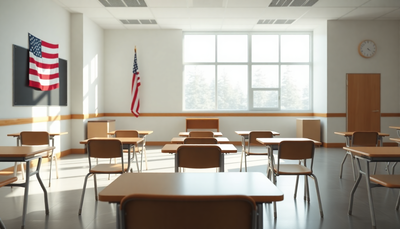The United States of divergence: How ethnic studies became a fault line in American education

California once led the charge to revolutionize public education. When it passed a landmark law in 2021 requiring ethnic studies for all high school graduates, the state positioned itself as a national trailblazer, promising a curriculum that would finally center the stories of those long left at the margins. From farmworker movements and Indigenous resistance to the lingering consequences of settler colonialism, the course aimed to reflect the full spectrum of California’s history.But four years later, that promise is being slowly pulled apart, undone not by lack of interest, but by a rising tide of political anxiety, lawsuits, and ideological warfare. What was meant to unify a generation around shared truths has instead exposed a nation splintered over what truth even is.
From inclusion to indictment
Ethnic studies, as envisioned, were never meant to be neutral. Born out of student protests in the 1960s, it challenged the eurocentrism of American education and demanded space for the voices of Black, Latino, Asian American, and Indigenous communities. Over the decades, the discipline evolved into a rich, intersectional field that questioned power structures, celebrated community histories, and encouraged resistance to injustice.California’s mandate attempted to translate that academic tradition into a K–12 setting, boldly, perhaps too boldly. In doing so, it placed young students in the crosshairs of a national culture war that had already weaponized terms like “critical race theory,” “indoctrination,” and “parental rights.”At the heart of the backlash lies a fundamental tension: Can a public school teach about oppression without being accused of promoting division? Can it introduce students to global struggles for justice without inviting political condemnation? California’s ethnic studies experiment has become the proving ground for those questions, and the answers remain bitterly contested.
A curriculum without a center
The state’s original model curriculum was ambitious, academic, and unapologetically grounded in social critique. But early drafts ignited protest, particularly from Jewish groups who objected to its framing of Israel as a colonial power, and from conservative activists who equated its themes with ideological overreach. Amid the uproar, the state board of education intervened, scrapping the original draft and replacing it with a more sanitized version.In the vacuum left behind, alternative models began to emerge. Some teachers embraced a grassroots, “liberated” curriculum that retained the original spirit of the discipline, hyper-local histories, resistance movements, and comparative studies that linked US histories of oppression to global struggles, including that of Palestinians. Others stuck to milder, state-vetted material that diluted the course’s critical edge.The result: A curriculum landscape as fragmented as the nation itself. In some classrooms, students explore gentrification through local archives. In others, they barely graze the surface of systemic inequality. Ethnic studies has no singular face in California; it reflects the contradictions of a state caught between progressivism and political caution.
Lawsuits, backlash, and the ghost of 2020
What followed the 2020 racial justice uprisings was not a new consensus on equity, it was a deepening polarization. The ethnic studies requirement, passed in the momentum of that national reckoning, now finds itself out of step with a country recoiling from the very reforms it once applauded.Across California, lawsuits allege antisemitism, exclusion, and ideological bias in ethnic studies classrooms. In San Jose, plaintiffs claim their children were shamed for being Jewish. In Santa Ana, the district settled after complaints that Jewish parents were excluded from curriculum discussions. Meanwhile, in San Francisco, the school district preemptively paused its ethnic studies rollout, wary of controversy.At the same time, educators are facing retribution for what they teach, or for simply trying to teach. Teachers who dare to address Israel-Palestine are suspended or sued. Others self-censor or quit altogether. And in April, the governor quietly withheld funding tied to the mandate, raising questions about the state’s commitment to its own vision.
What’s at stake isn’t just a course
The battle over ethnic studies is not simply about one subject. It is about whether America can agree on the purpose of public education. Should schools prepare students for a diverse, global society, or shield them from discomfort? Should students encounter contested histories, or only those that flatter dominant narratives?For decades, the US education system claimed to uphold democratic values by promoting informed citizenship. But that promise is hollow when lessons on race, colonization, and identity become political liabilities. Ethnic studies, in this light, isn’t just a curriculum, it’s a litmus test for whether democracy can survive disagreement in the classroom.
A divided republic of knowledge
As ethnic studies teeters between progress and paralysis, a larger truth comes into view: the United States no longer shares a common educational narrative. Where one school district sees empowerment, another sees indoctrination. Where one community demands exposure to hard histories, another demands opt-outs, bans, and litigation.This isn’t just a California problem; it’s an American one. A nation that cannot agree on whose stories deserve space in the classroom cannot sustain a public education system grounded in unity, let alone empathy.California tried to lead. But in trying to teach the full story, it revealed how few Americans agree on what that story is.
The future, fragmented
If the ethnic studies mandate collapses under pressure, or survives in name but not in substance, it will mark more than the failure of one policy. It will be a warning sign that even the most diverse, progressive state in the union could not shield its schools from the centrifugal forces pulling the country apart.The classroom is no longer a neutral space. It is a mirror of a nation increasingly defined by what it refuses to teach.And that may be the most dangerous lesson of all.





